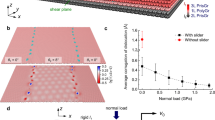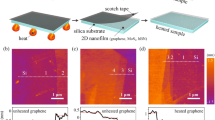Abstract
Graphite and other lamellar materials are used as dry lubricants for macroscale metallic sliding components and high-pressure contacts. It has been shown experimentally that monolayer graphene exhibits higher friction than multilayer graphene and graphite, and that this friction increases with continued sliding, but the mechanism behind this remains subject to debate. It has long been conjectured that the true contact area between two rough bodies controls interfacial friction1. The true contact area, defined for example by the number of atoms within the range of interatomic forces, is difficult to visualize directly but characterizes the quantity of contact. However, there is emerging evidence that, for a given pair of materials, the quality of the contact can change, and that this can also strongly affect interfacial friction2,3,4,5,6,7. Recently, it has been found that the frictional behaviour of two-dimensional materials exhibits traits8,9,10,11,12,13 unlike those of conventional bulk materials. This includes the abovementioned finding that for few-layer two-dimensional materials the static friction force gradually strengthens for a few initial atomic periods before reaching a constant value. Such transient behaviour, and the associated enhancement of steady-state friction, diminishes as the number of two-dimensional layers increases, and was observed only when the two-dimensional material was loosely adhering to a substrate8. This layer-dependent transient phenomenon has not been captured by any simulations14,15. Here, using atomistic simulations, we reproduce the experimental observations of layer-dependent friction and transient frictional strengthening on graphene. Atomic force analysis reveals that the evolution of static friction is a manifestation of the natural tendency for thinner and less-constrained graphene to re-adjust its configuration as a direct consequence of its greater flexibility. That is, the tip atoms become more strongly pinned, and show greater synchrony in their stick–slip behaviour. While the quantity of atomic-scale contacts (true contact area) evolves, the quality (in this case, the local pinning state of individual atoms and the overall commensurability) also evolves in frictional sliding on graphene. Moreover, the effects can be tuned by pre-wrinkling. The evolving contact quality is critical for explaining the time-dependent friction of configurationally flexible interfaces.
This is a preview of subscription content, access via your institution
Access options
Subscribe to this journal
Receive 51 print issues and online access
$199.00 per year
only $3.90 per issue
Buy this article
- Purchase on Springer Link
- Instant access to full article PDF
Prices may be subject to local taxes which are calculated during checkout




Similar content being viewed by others
References
Szlufarska, I., Chandross, M. & Carpick, R. W. Recent advances in single-asperity nanotribology. J. Phys. D 41, 123001 (2008)
Dienwiebel, M. et al. Superlubricity of graphite. Phys. Rev. Lett. 92, 126101 (2004)
Filippov, A. E., Dienwiebel, M., Frenken, J. W. M., Klafter, J. & Urbakh, M. Torque and twist against superlubricity. Phys. Rev. Lett. 100, 046102 (2008)
Kim, W. K. & Falk, M. L. Atomic-scale simulations on the sliding of incommensurate surfaces: the breakdown of superlubricity. Phys. Rev. B 80, 235428 (2009)
van Wijk, M., Dienwiebel, M., Frenken, J. & Fasolino, A. Superlubric to stick-slip sliding of incommensurate graphene flakes on graphite. Phys. Rev. B 88, 235423 (2013)
Li, Q., Tullis, T. E., Goldsby, D. & Carpick, R. W. Frictional ageing from interfacial bonding and the origins of rate and state friction. Nature 480, 233–236 (2011)
Liu, Y. & Szlufarska, I. Chemical origins of frictional aging. Phys. Rev. Lett. 109, 186102 (2012)
Lee, C. et al. Frictional characteristics of atomically thin sheets. Science 328, 76–80 (2010)
Chhowalla, M. & Amaratunga, G. A. Thin films of fullerene-like MoS2 nanoparticles with ultralow friction and wear. Nature 407, 164–167 (2000)
Choi, J. S. et al. Friction anisotropy-driven domain imaging on exfoliated monolayer graphene. Science 333, 607–610 (2011)
Deng, Z. et al. Nanoscale interfacial friction and adhesion on supported versus suspended monolayer and multilayer graphene. Langmuir 29, 235–243 (2013)
Cho, D.-H. et al. Effect of surface morphology on friction of graphene on various substrates. Nanoscale 5, 3063–3069 (2013)
Filleter, T. et al. Friction and dissipation in epitaxial graphene films. Phys. Rev. Lett. 102, 086102 (2009)
Ye, Z., Tang, C., Dong, Y. & Martini, A. Role of wrinkle height in friction variation with number of graphene layers. J. Appl. Phys. 112, 116102 (2012)
Smolyanitsky, A., Killgore, J. & Tewary, V. Effect of elastic deformation on frictional properties of few-layer graphene. Phys. Rev. B 85, 035412 (2012)
Ishigami, M., Chen, J. H., Cullen, W. G., Fuhrer, M. S. & Williams, E. D. Atomic structure of graphene on SiO2 . Nano Lett. 7, 1643–1648 (2007)
Mate, C. M., McClelland, G. M., Erlandsson, R. & Chiang, S. Atomic-scale friction of a tungsten tip on a graphite surface. Phys. Rev. Lett. 59, 1942–1945 (1987)
Bonelli, F., Manini, N., Cadelano, E. & Colombo, L. Atomistic simulations of the sliding friction of graphene flakes. Eur. Phys. J. B 70, 449–459 (2009)
Li, Q., Lee, C., Carpick, R. W. & Hone, J. Substrate effect on thickness-dependent friction on graphene. Phys. Stat. Sol. B 247, 2909–2914 (2010)
Luan, B. & Robbins, M. O. The breakdown of continuum models for mechanical contacts. Nature 435, 929–932 (2005)
He, G., Müser, M. H. & Robbins, M. O. Adsorbed layers and the origin of static friction. Science 284, 1650–1652 (1999)
Liu, Z. et al. Observation of microscale superlubricity in graphite. Phys. Rev. Lett. 108, 205503 (2012)
Mohammadi, H. & Müser M. H. Friction of wrinkles. Phys. Rev. Lett. 105, 224301 (2010)
Spear, J. C., Custer, J. P. & Batteas, J. D. The influence of nanoscale roughness and substrate chemistry on the frictional properties of single and few layer graphene. Nanoscale 7, 10021–10029 (2015)
Tersoff, J. Empirical interatomic potential for carbon, with applications to amorphous carbon. Phys. Rev. Lett. 61, 2879–2882 (1988)
Stillinger, F. H. & Weber, T. A. Computer simulation of local order in condensed phases of silicon. Phys. Rev. B 31, 5262–5271 (1985)
Zacharia, R., Ulbricht, H. & Hertel, T. Interlayer cohesive energy of graphite from thermal desorption of polyaromatic hydrocarbons. Phys. Rev. B 69, 155406 (2004)
Zong, Z., Chen, C.-L., Dokmeci, M. R. & Wan, K.-t. Direct measurement of graphene adhesion on silicon surface by intercalation of nanoparticles. J. Appl. Phys. 107, 026104 (2010)
Koenig, S. P., Boddeti, N. G., Dunn, M. L. & Bunch, J. S. Ultrastrong adhesion of graphene membranes. Nat. Nanotechnol. 6, 543–546 (2011)
Nosé, S. A unified formulation of the constant temperature molecular-dynamics methods. J. Chem. Phys. 81, 511–519 (1984)
Plimpton, S. Fast parallel algorithms for short-range molecular dynamics. J. Comput. Phys. 117, 1–19 (1995)
Li, J. AtomEye: an efficient atomistic configuration viewer. Model. Simul. Mater. Sci. Eng. 11, 173 (2003)
Giannazzo, F., Sonde, S., Nigro, R. L., Rimini, E. & Raineri, V. Mapping the density of scattering centers limiting the electron mean free path in graphene. Nano Lett. 11, 4612–4618 (2011)
Acknowledgements
S.L. and P.G. appreciate support from the Alexander von Humboldt Foundation and the Helmholtz Programme Science and Technology of Nanosystems (STN). Q.L., X.D. and J.S. appreciate support from the 973 Programs of China (grant numbers 2013CB933003, 2013CB934201, 2015CB351903 and 2012CB619402), the NSFC (grant numbers 11422218, 11272177, 11432008, 51320105014 and 51321003), the International Joint Laboratory for Micro/Nano Manufacturing and Measurement Technologies, the Tsinghua University Initiative Scientific Research Program (grant number 2014Z01007), the Thousand Young Talents Program of China and 111 project (grant number B06025). R.W.C. acknowledges support from the NSF (grant numbers CMMI-1401164 and MRSEC DMR-1120901). J.L. acknowledges support from the NSF (grant numbers MRSEC DMR-1120901, CBET-1240696, DMR-1410636 and ECCS-1610806). We also thank J. Feng for discussions.
Author information
Authors and Affiliations
Contributions
Q.L., R.W.C. and J.L. conceived and designed the project. S.L. performed molecular dynamics simulations. Q.L., R.W.C. and X.Z.L. provided information about the atomic force microscope experiments. Q.L., P.G., X.D., J.S. and J.L. provided the simulation guideline. S.L., Q.L., R.W.C. and J.L. wrote the paper. All authors contributed to discussions and analyses of the results.
Corresponding authors
Ethics declarations
Competing interests
The authors declare no competing financial interests.
Supplementary information
Supplementary Information
This file contains Supplementary Discussions 1-14, Supplementary Figures 1-18, Supplementary Table 1 and Supplementary References. It provides the additional information for the simulation results and relevant discussions. (PDF 7143 kb)
Evolution of graphene configuration during sliding in 1L/a-Si substrate system
This video shows the evolution of graphene configuration of 1L graphene/a-Si substrate in a 2.5nm scan. Colours are shown according to the height amplitude of graphene along the y direction. (MP4 15096 kb)
Rights and permissions
About this article
Cite this article
Li, S., Li, Q., Carpick, R. et al. The evolving quality of frictional contact with graphene. Nature 539, 541–545 (2016). https://doi.org/10.1038/nature20135
Received:
Accepted:
Published:
Issue Date:
DOI: https://doi.org/10.1038/nature20135
This article is cited by
-
Contact Stiffness and Damping in Atomic-Scale Friction: An Approximate Estimation from Molecular Dynamics Simulations
Tribology Letters (2024)
-
Friction hysteretic behavior of supported atomically thin nanofilms
npj 2D Materials and Applications (2023)
-
Effect of Strain on Atomic-Scale Friction in Two-Dimensional Graphene/ZrS2 van der Waals Heterostructure
Tribology Letters (2023)
-
Graphene superlubricity: A review
Friction (2023)
-
Electronic friction and tuning on atomically thin MoS2
npj 2D Materials and Applications (2022)
Comments
By submitting a comment you agree to abide by our Terms and Community Guidelines. If you find something abusive or that does not comply with our terms or guidelines please flag it as inappropriate.



